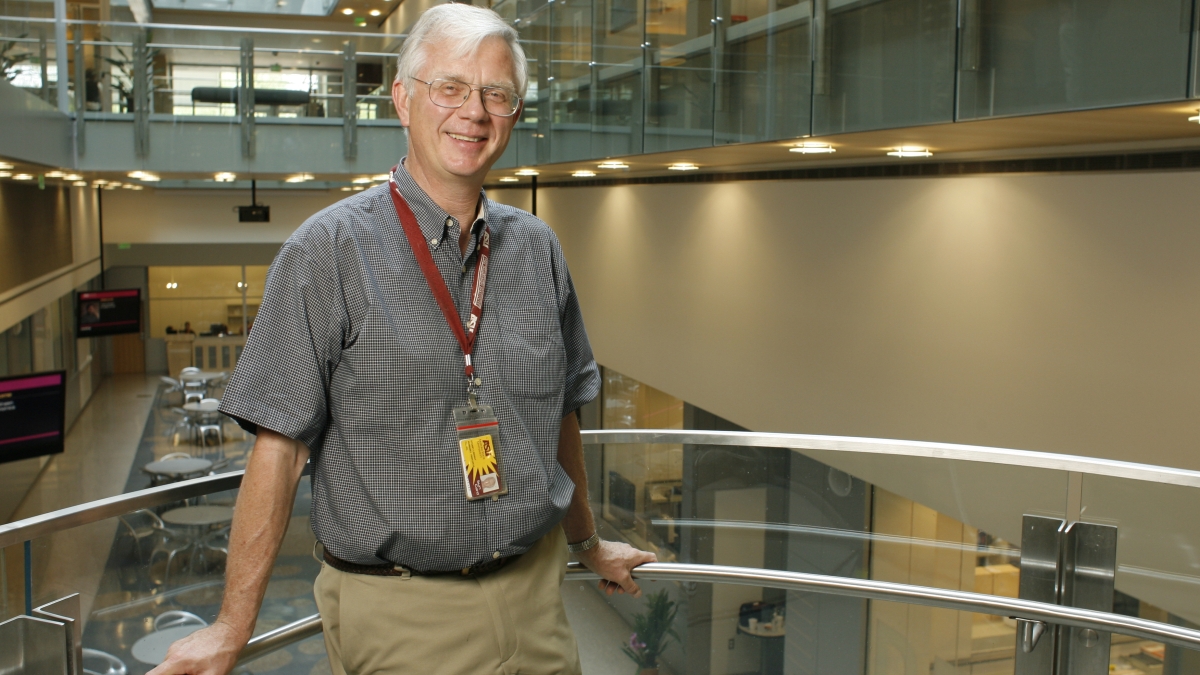ASU receives major NIH awards to pursue revolutionary DNA sequencing

Two ASU Biodesign Institute researchers have been awarded more than $5 million in funds from the National Institutes of Health (NIH) to pursue the development of a revolutionary, next-generation DNA sequencing device to rapidly sequence a person’s complete DNA information, or genome, for $1000 or less.
Biodesign researchers Stuart Lindsay and Bharath Takulapalli received the grants from the National Human Genome Research Institute (NHGRI), part of NIH, to develop technologies to enable the everyday use of DNA sequencing technologies by biomedical researchers and health care providers.
“Our promising approach, which combines advances in physics, electronics and nanotechnology, eliminates the need for the use of the major cost of sequencing today – namely, the use of chemical reagents – to read an individual’s genome,” said Lindsay, an ASU Regents’ Professor and director of the Biodesign Institute’s Center for Single Molecule Biophysics.
“We are confident that NHGRI grantees will continue to make major breakthroughs in the development of technologies that will sequence a human genome for $1,000 or less,” said Eric D. Green, director of NHGRI. “As genome sequencing costs continue to decline, researchers and clinicians can increase the scale and scope of their studies. We will continue to fund innovations to accelerate what is known about human health and disease."
During the past decade, DNA sequencing costs have fallen dramatically, fueled in large part by tools, technologies and process improvements developed by the Human Genome Project. Since 2004, NHGRI launched major programs to accelerate improvements in sequencing technologies and to drive down the costs. Today, the cost to sequence a human genome using next-generation sequencing has dipped below $20,000.
“With advances in a ‘third generation’ of DNA sequencing technologies, we’re moving closer to the point when researchers and health care providers can routinely and rapidly screen a person’s, or large numbers of people’s, genome using devices that produce highly accurate data,” said Jeff Schloss, NHGRI's program director for technology development.
ASU was the only university to receive more than one award. In total, the NHGRI funded nine teams to develop revolutionary technologies that can meet the $1,000 per genome goal. The approaches will integrate biochemistry, chemistry and physics with engineering to develop the third generation of DNA sequencing and analysis technologies.
ASU has received several multi-million awards since the NHGRI program was launched. Lindsay’s research team will use a new four-year, $4.1 million NHGRI award to pursue the development of a device that can rapidly read the human genome.
The technology, which Lindsay calls recognition tunneling, reads the DNA sequence as a single DNA molecule is passed through an atomic-thin nanopore like thread through the eye of a needle. The team has developed proof-of-concept for the technology with the ability to distinguish among the four individual chemical components of the DNA code (referred as C, G, A, T) and now wants to translate their discoveries into a commercial instrument to optimize the DNA sequencing.
“We are in the midst of making a third generation reader molecule that gives us larger signals with better discrimination between the DNA bases,” Lindsay said. “Another challenge will be to control the speed of the DNA as it passes through the nanopore so that we can read the sequence as rapidly as possible while still getting a precise recognition signal.”
Fellow Biodesign researcher Bharath Takulapalli will be pursuing a slightly different, yet parallel approach during his three-year $916,000 NHGRI award. Takulapalli, an electrical engineering expert, will focus on making improvements to both the nanopore sensor and device, with an emphasis on reading the DNA at very high speeds as it passes through a sensing technology based in part on a semiconductor staple called field-effect transistors (FETs). FETs control the flow of electrons in transistors and serve as the basis for modern digital integrated circuits found in computers and smart phones.
“As Stuart Lindsay mentions, we have to find the sweet spot to control the rate at which DNA travels through the nanopore,” said Takulapalli, an assistant research scientist at the institute’s Virginia G. Piper Center for Personalized Diagnostics. “We want to ensure a maximum DNA signal with minimal noise.” If successful, the approach has the potential to read up to 100,000 DNA bases per second, or a whole genome in a few minutes.
“This is no doubt a daunting task, but if successful, would represent a high payoff breakthrough in DNA sequencing, providing long reads, and a high-throughput at low-cost,” Takulapalli said.
Together, the ASU duo hopes to advance the full potential of the technology toward a day when low-cost, DNA sequencing will become a standard part of everyday medical care.
Written by Joe Caspermeyer & Geoff Spencer (NHGRI)
Joe Caspermeyer, joseph.caspermeyer@asu.edu
Biodesign Institute